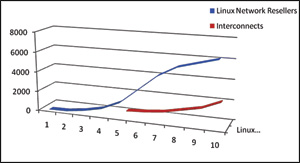|
September 2008 | Volume 11 / Number 9
The Channel Perspective
VoIP/Asterisk Channel Evolution
One of the major limiting factors is the actual media that carries the signal. When voice was first carried over the Internet, the technology of the day was based on 4800 and 9600BPS modems. Based on today’s standards and the demand for QoS, it is understandable why VoIP took so long to evolve. Large telephony manufacturers also provided significant resistance to VoIP’s evolution. The large manufacturers already controlled the market. Their current equipment based on TDM provided large margins and was very profitable. Moving to VoIP meant changing the infrastructure and that would change the profitability of the telephony manufacturer . The channel itself also provided significant resistance to VoIP. The telephony manufacturers, resellers or “interconnects” had complete product lines and were making good margins with their sales. There was no need to move to VoIP. The word on the street was that VoIP did not deliver a quality solution. The manufacturers also protected the margins of the resellers making the resellers loyal to their existing suppliers and resistant to new VoIP suppliers that do not understand channels. As the interconnects know, they are the sales force for the telephone companies and manufacturers. They are the feet on the street. They are the direct link to the consumer of the telephony services and equipment. Their margins need to be protected through channel controls. Most VoIP manufacturers do not know the meaning of channels or they are trying to redefine the channel. Unfortunately for them, the VoIP companies that succeed will be the ones that develop a strong channel strategy. Selling to everyone that calls a manufacturer to order is not a channel strategy. VoIP Enabling FactorsSIP and RTP both have had a major impact on the evolution of VoIP. During the 1990s, user demand for high speed connections for use with the Internet increased tremendously. This also gave momentum to VoIP. Now users were able to use DSL and cable for the Internet as well as VoIP. More businesses were signing up for affordable T1s providing them the bandwidth necessary to use VoIP. Everything was starting to come together.
With the dot-com bust, Linux networking resellers were looking for the next gold mine. They soon came to realize that they had found it in telephony and VoIP. Asterisk enabled them to inexpensively deliver telephony to their existing networking customers as well as expand their customer base. Thus, the Linux networking reseller and Asterisk combined to put pressure on the major telephony providers to start moving to VoIP. By the end of 2005, the major telcos committed to moving to VoIP. The Linux networking channel and Asterisk have had a profound impact on the telephony industry. Linux resellers have been on the VoIP bandwagon from the beginning. As indicated in the chart accompanying this column, the Linux resellers were early adopters. They really had no competition from the traditional telephony reseller until just recently. Even now, the interconnects are using VoIP solutions offered by the major telco providers. This trend has been easy to monitor. The major manufacturers of traditional telephony equipment sell their products through national distributors. The new VoIP products do not meet the national distributor requirements and the manufacturers have had to find smaller regional distributors or VoIP specialty distributors like Cylogistics. Now that the interconnects are interested in Asterisk and VoIP, they must find suppliers of the emerging VoIP technology. Cylogistics, being one of those suppliers, is now getting a number of calls from the interconnect market segment and is seeing a significant increase in interconnect inquiries. VoIP is now in full swing. The bandwidth is there. The infrastructure is there. Moreover, the channel is there for those that choose to use it. IT Footnote: 1 Jackson, Barry. “History of VoIP”. University of Texas at Dallas. Retrieved on July 11, 2008. Don Witt is President of Cylogistics (www.cylogistics.com). Today @ TMC
Headlines
Upcoming Events
MSPWorld
The World's Premier Managed Services and Cloud Computing Event Click for Dates and Locations Corporate News
|
|





 Starting from meager beginnings over three decade’s ago1, VoIP is a technology that is reshaping the telephony industry. A number of factors have provided resistance to the evolution of VoIP and others that have enabled VoIP to flourish.
Starting from meager beginnings over three decade’s ago1, VoIP is a technology that is reshaping the telephony industry. A number of factors have provided resistance to the evolution of VoIP and others that have enabled VoIP to flourish. Asterisk (
Asterisk (
